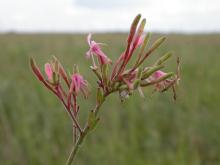Wildflowers, Grasses and Other Nonwoody Plants
Media
Species Types
Scientific Name
Vernonia baldwinii
Description
Ironweeds are tough, grayish-green, branching plants known for their fluffy-looking clusters of reddish-purple florets. They are a familiar sight on roadsides and pastures. Identify western ironweed by the bracts at the base of the flowerheads.
Media

Species Types
Scientific Name
Geranium maculatum
Description
Called “crane’s bill” for its sharply pointed seed capsules, wild geranium is a gardening favorite, and there are cultivated varieties of this woodland wildflower bred for unique petal and leaf colors.
Media

Species Types
Scientific Name
Podophyllum peltatum
Description
Mayapple is a common spring wildflower that makes its biggest impression with its leaves, which resemble umbrellas arising from a single stalk. It often grows in colonies.
Media

Species Types
Scientific Name
Cirsium vulgare
Description
Bull thistle is a weedy introduction from Europe, found statewide. To tell it from our other thistles, note its stems with spiny-margined wings, and its leaves with the upper surface strongly roughened with stiff, spiny bristles.
Media

Species Types
Scientific Name
Cirsium altissimum
Description
Tall thistle is a native thistle that can grow to be 10 feet tall! To identify it, notice its leaves, which are unlobed (though they may be wavy or have only shallow, broad lobes), are felty-hairy beneath, and have prickles only along the edges.
Media

Species Types
Scientific Name
Hibiscus lasiocarpos
Description
Hibiscus in Missouri? You bet! Hairy rose mallow is a native perennial whose 6-inch-wide blossoms look a lot like those of its tropical relatives. The stalks can get woody and can grow to 8 feet tall.
Media

Species Types
Scientific Name
Physostegia virginiana
Description
False dragonhead is called "obedient plant" because when you push one of the flowers sideways, it "obediently" stays in place for a while.
Media

Species Types
Scientific Name
Blephilia ciliata
Description
Square, unbranching stems, opposite leaves, two-lipped flowers, and a mild minty fragrance are clues Ohio horsemint is in the mint family. Tight, rounded flower clusters are stacked atop one another at the stem tips.
Media

Species Types
Scientific Name
Lippia lanceolata (formerly Phyla lanceolata)
Description
Common in almost any kind of moist, wet or muddy habitat, fog fruit bears interesting round, purple flower heads that are ringed by small, white or pinkish flowers.
Media

Species Types
Scientific Name
Oenothera filiformis (formerly Gaura longiflora, G. biennis)
Description
Large-flowered gaura is a tall plant whose white flowers turn pinkish as they age. Four petals point upward, then bend back, and 8 stamens droop downward. The flowers look something like small butterflies.
See Also
About Wildflowers, Grasses and Other Nonwoody Plants in Missouri
A very simple way of thinking about the green world is to divide the vascular plants into two groups: woody and nonwoody (or herbaceous). But this is an artificial division; many plant families include some species that are woody and some that are not. The diversity of nonwoody vascular plants is staggering! Think of all the ferns, grasses, sedges, lilies, peas, sunflowers, nightshades, milkweeds, mustards, mints, and mallows — weeds and wildflowers — and many more!





















